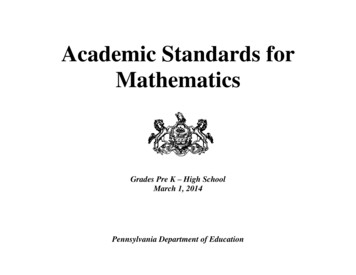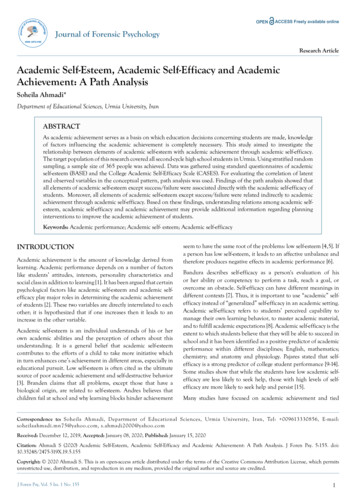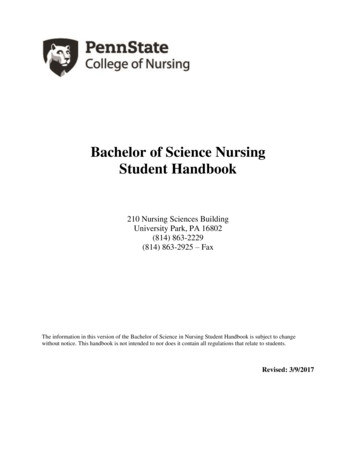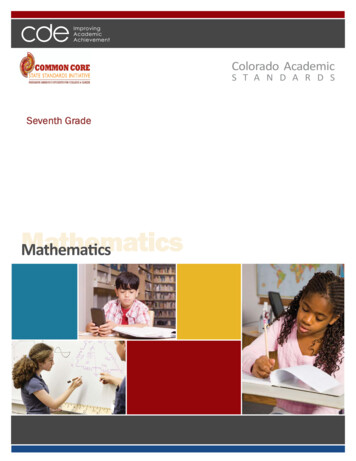
Transcription
Academic Standards forMathematicsGrades Pre K – High SchoolMarch 1, 2014Pennsylvania Department of Education
PA CORE STANDARDSMathematicsINTRODUCTIONThe Pennsylvania Core Standards in Mathematics in grades PreK–5 lay a solid foundation in whole numbers, addition, subtraction, multiplication,division, fractions, and decimals. Taken together, these elements support a student’s ability to learn and apply more demanding math concepts andprocedures. The middle school and high school standards call on students to practice applying mathematical ways of thinking to real world issues andchallenges; they prepare students to think and reason mathematically. Additionally, they set a rigorous definition of college and career readiness bydemanding that students develop a depth of understanding and ability to apply mathematics to novel situations, as college students and employeesregularly do. Although the standards are not a curriculum or a prescribed series of activities, school entities will use them to develop a local schoolcurriculum that will meet local students’ needs.This document includes PA Core Standards for Mathematical Content and Mathematical Practice. The mathematics standards define whatstudents should understand and be able to do. Mathematical Practice Standards describes the habits of mind required to reach a level of mathematicalproficiency.PA Core StandardsMathematical Content and Mathematical PracticeStandards for Mathematical Content2.1 Numbers and OperationsA) Counting and CardinalityB) Numbers and Operations in Base TenC) Numbers and Operations—FractionsD) Ratios and Proportional RelationshipsE) The Number SystemF) Number and Quantity2.2 Algebraic ConceptsA) Operations and Algebraic ThinkingB) Expressions & EquationsC) FunctionsD) Algebra2.3 GeometryA) GeometryStandards for Mathematical Practice Make sense of problems and persevere in solving them.Reason abstractly and quantitatively.Construct viable arguments and critique the reasoning of others.Model with mathematics.Use appropriate tools strategically.Attend to precision.Look for and make use of structure.Look for and make sense of regularity in repeated reasoning.2.4 Measurement, Data, and ProbabilityA) Measurement and DataB) Statistics and Probability P a g e 2March 1, 2014
PA CORE STANDARDSMathematicsStandards cannot be viewed or addressed in isolation, as each standard depends upon or may lead into multiple standards across grades; thus, it isimperative that educators are familiar with both the standards that come before and those that follow a particular grade level. These revised standardsreflect instructional shifts that cannot occur without the integrated emphasis on content and practice.Standards are overarching statements of what a proficient math student should know and be able to do. The Pennsylvania Assessment Anchors andEligible Content closely align with the revised standards and are an invaluable source for greater detail.Key Points in Mathematics The standards stress both procedural skills and conceptual understanding to ensure students are learning and applying the criticalinformation they need to succeed at higher levels. K–5 standards, which provide students with a solid foundation in whole numbers, addition, subtraction, multiplication, division,fractions, and decimals, help young students build the foundation to successfully apply more demanding math concepts andprocedures, and move into application. They also provide detailed guidance to teachers on how to navigate their way through topicssuch as fractions, negative numbers, and geometry, and do so by maintaining a continuous progression from grade to grade. Having built a strong foundation at K–5, students can do hands-on learning in geometry, algebra, and probability and statistics.Students who have mastered the content and skills through the seventh grade will be well-prepared for algebra in grade 8. High school standards emphasize practicing applying mathematical ways of thinking to real world issues and challenges. P a g e 3March 1, 2014
PA CORE STANDARDSMathematicsThe PA Core Standards for Mathematics detail four standard areas: Numbers and Operations, Algebraic Concepts, Geometry, and Measurement,Data, and Probability. These standard areas are reflective of the reporting categories in the PA Core Assessment Anchors and Eligible Content. Theintent of this document is to provide a useful tool for designing curriculum, instruction, and assessment. The grade level curriculum and instructionalshifts in mathematics cannot occur without the integrated emphasis on content and practice. The chart below illustrates the four standard areas andthe development and progression of the strands, with an understanding that all is framed around the Standards for Mathematical Practice.Mathematical Standards: Development and ProgressionStandards for Mathematical PracticeMake sense of problems and persevere in solving them.Construct viable arguments and critique the reasoning of others.Use appropriate tools strategically.Look for and make use of structure.PreKK12Reason abstractly and quantitatively.Model with mathematics.Attend to precision.Look for and express regularity in repeated reasoning.345678HS(A) Counting &Cardinality2.1Numbers andOperations(B) Numbers and Operations in Base Ten(C) Numbers and Operations —Fractions2.2AlgebraicConcepts(A) Operations and Algebraic Thinking(F) Numberand Quantity(E) The Number System(B) Expressions and Equations(D) Algebra(C) Functions2.3Geometry2.4Measurement,Data, andProbability(D) Ratios andProportionalRelationships(A) Geometry(A) Measurement and Data(B) Statistics and Probability P a g e 4March 1, 2014
PA CORE STANDARDSMathematics2.1 Numbers and OperationsThe Standards of Mathematical PracticesMake sense of problems and persevere in solving them.Reason abstractly and quantitatively.Construct viable arguments and critique the reasoning of others.Model with mathematics.Use appropriate tools strategically.Attend to precision.Look for and make use of structure.Look for and express regularity in repeated reasoning.Grade PreKGrade KGrade 1Grade 2Grade 3Grade 42.1.PreK2.1.K2.1.12.1.22.1.32.1.4Grade 52.1.5(B) Numbers & Operations in Base Ten(A) Counting &CardinalityPennsylvania’s public schools shall teach, challenge, and support every student to realize his or her maximum potential and to acquire the knowledge and skills needed to:CC.2.1.PreK.A.1CC.2.1.K.A.1Know number namesKnow number names andand the count sequence.write and recite the countsequence.CC.2.1.PreK.A.2CC.2.1.K.A.2Count to tell the number Apply one-to-oneIntentionally BlankIntentionally BlankIntentionally BlankIntentionally BlankIntentionally Blankof objects.correspondence to countthe number of objects.CC.2.1.PreK.A.3CC.2.1.K.A.3Compare numbers.Apply the concept ofmagnitude to comparenumbers and 2.1.3.B.1CC.2.1.4.B.1CC.2.1.5.B.1Use place value toExtend the countingUse place-valueApply place-valueApply place-valueApply place-valuecompose and decomposesequence to read andconcepts to representunderstanding andconcepts to show anconcepts to show annumbers within 19.write numerals toamounts of tens andproperties of operationsunderstanding of multiunderstanding ofrepresent objects.ones and to compareto perform multi-digitdigit whole numbers.operations and roundingthree digit numbers.arithmetic.as they pertain to wholeM04.A-T.1.1.1numbers and 2CC.2.1.5.B.2Use place-value conceptsUse place-valueUse place-valueExtend an understandingIntentionally Blankto represent amounts ofconcepts to read, write,understanding andof operations with wholetens and ones and toand skip count to 1000.properties of operations numbers to performcompare two digitto perform multi-digitoperations includingIntentionally A-T.2.1.2M04.A-T.2.1.3M04.A-T.2.1.4Intentionally BlankCC.2.1.1.B.3Use place-value conceptsand properties ofoperations to add andsubtract within 100.CC.2.1.2.B.3Use place-valueunderstanding andproperties of operationsto add and subtractwithin 1000.Intentionally BlankIntentionally ionally Blank P a g e 5March 1, 2014
PA CORE STANDARDSMathematics2.1 Numbers and OperationsThe Standards of Mathematical PracticesMake sense of problems and persevere in solving them.Reason abstractly and quantitatively.Construct viable arguments and critique the reasoning of others.Model with mathematics.Use appropriate tools strategically.Attend to precision.Look for and make use of structure.Look for and express regularity in repeated reasoning.Grade PreKGrade KGrade 1Grade 2Grade 3Grade 42.1.PreK2.1.K2.1.12.1.22.1.32.1.4Grade 52.1.5Pennsylvania’s public schools shall teach, challenge, and support every student to realize his or her maximum potential and to acquire the knowledge and skills needed to:(C) Numbers & Operations — FractionsCC.2.1.3.C.1Explore and develop anunderstanding offractions as .A-F.1.1.4M03.A-F.1.1.5Intentionally BlankIntentionally BlankIntentionally BlankIntentionally BlankIntentionally BlankIntentionally BlankCC.2.1.4.C.1Extend theunderstanding offractions to showequivalence andordering.CC.2.1.5.C.1Use the understanding ofequivalency to add andsubtract C.2.1.4.C.2Build fractions fromunit fractions byapplying and extendingpreviousunderstandings ofoperations on .1.7CC.2.1.4.C.3Connect decimalnotation to fractions,and compare decimalfractions (base 10denominator, e.g.,19/100).CC.2.1.5.C.2Apply and extendprevious understandingsof multiplication anddivision to multiply anddivide 05.A-F.2.1.4Intentionally BlankM04.A-F.3.1.1M04.A-F.3.1.2M04.A-F.3.1.3 P a g e 6March 1, 2014
PA CORE STANDARDSMathematics2.2 Algebraic ConceptsThe Standards of Mathematical PracticesMake sense of problems and persevere in solving them.Reason abstractly and quantitatively.Construct viable arguments and critique the reasoning of others.Model with mathematics.Use appropriate tools strategically.Attend to precision.Look for and make use of structure.Look for and express regularity in repeated reasoning.Grade PreKGrade KGrade 1Grade 2Grade 3Grade 42.2.PreK2.2.K2.2.12.2.22.2.32.2.4Grade 52.2.5Pennsylvania’s public schools shall teach, challenge, and support every student to realize his or her maximum potential and to acquire the knowledge and skills needed to:(A) Operations and Algebraic ThinkingCC.2.2.PreK.A.1Understand addition asputting together andadding to, andunderstand subtractionas taking apart andtaking from.Intentionally BlankIntentionally BlankCC.2.2.K.A.1Extend the concepts ofputting together andtaking apart to add andsubtract within 10.Intentionally BlankIntentionally BlankCC.2.2.1.A.1Represent and solveproblems involvingaddition and subtractionwithin 20.CC.2.2.1.A.2Understand and applyproperties of operationsand the relationshipbetween addition andsubtraction.Intentionally BlankCC.2.2.2.A.1Represent and solveproblems involvingaddition andsubtraction within 100.CC.2.2.2.A.2Use mental strategies toadd and subtract within20.CC.2.2.2.A.3Work with equal groupsof objects to gainfoundations formultiplication.CC.2.2.3.A.1Represent and solveproblems involvingmultiplication 1M03.B-O.1.2.2CC.2.2.3.A.2Understand properties ofmultiplication and therelationship betweenmultiplication 1CC.2.2.3.A.3Demonstratemultiplication anddivision fluency.CC.2.2.3.A.4Solve problems involvingthe four operations, andidentify and explainpatterns in arithmetic.Intentionally BlankIntentionally BlankIntentionally BlankIntentionally .2.4.A.1Represent and solveproblems involving thefour operations.CC.2.2.5.A.1Interpret and evaluatenumerical expressionsusing order of 2Develop and/or applynumber theory conceptsto find factors andmultiples.Intentionally BlankM04.B-O.2.1.1Intentionally BlankCC.2.2.4.A.4Generate and analyzepatterns using one ionally BlankCC.2.2.5.A.4Analyze patterns andrelationships using tworules.M05.B-O.2.1.1M05.B-O.2.1.2 P a g e 7March 1, 2014
PA CORE STANDARDSMathematics2.3 GeometryThe Standards of Mathematical PracticesMake sense of problems and persevere in solving them.Reason abstractly and quantitatively.Construct viable arguments and critique the reasoning of others.Model with mathematics.Use appropriate tools strategically.Attend to precision.Look for and make use of structure.Look for and express regularity in repeated reasoning.Grade PreKGrade KGrade 1Grade 2Grade 3Grade 4Grade a’s public schools shall teach, challenge, and support every student to realize his or her maximum potential and to acquire the knowledge and skills needed to:CC.2.3.PreK.A.1Identify and describeshapes.CC.2.3.K.A.1Identify and describetwo- and threedimensional shapes.CC.2.3.1.A.1Compose and distinguishbetween two- and threedimensional shapesbased on their attributes.CC.2.3.2.A.1Analyze and draw twoand three-dimensionalshapes having specifiedattributes.CC.2.3.3.A.1Identify, compare, andclassify shapes and theirattributes.(A) nalyze, compare,create, and composeshapes.CC.2.3.K.A.2Analyze, compare, create,and compose two- andthree-dimensionalshapes.CC.2.3.1.A.2Use the understanding offractions to partitionshapes into halves andquarters.CC.2.3.2.A.2Use the understandingof fractions to partitionshapes into halves,quarters, and thirds.CC.2.3.3.A.2Use the understanding offractions to partitionshapes into parts withequal areas and expressthe area of each part as aunit fraction of the whole.CC.2.3.4.A.1Draw lines and anglesand identify these lassify twodimensional figures byproperties of their linesand angles.M04.C-G.1.1.2M03.C-G.1.1.3Intentionally BlankIntentionally BlankIntentionally BlankIntentionally BlankIntentionally BlankCC.2.3.4.A.3Recognize symmetricshapes and draw lines ofsymmetry.CC.2.3.5.A.1Graph points in the firstquadrant on thecoordinate plane andinterpret these pointswhen solving real worldand 2.3.5.A.2Classify two-dimensionalfigures into categoriesbased on anunderstanding of theirproperties.M05.C-G.2.1.1Intentionally BlankM04.C-G.1.1.3 P a g e 8March 1, 2014
PA CORE STANDARDSMathematics2.4 Measurement, Data, and ProbabilityThe Standards of Mathematical PracticesMake sense of problems and persevere in solving them.Reason abstractly and quantitatively.Construct viable arguments and critique the reasoning of others.Model with mathematics.Use appropriate tools strategically.Attend to precision.Look for and make use of structure.Look for and express regularity in repeated reasoning.Grade PreKGrade KGrade 1Grade 2Grade 3Grade 4Grade a’s public schools shall teach, challenge, and support every student to realize his or her maximum potential and to acquire the knowledge and skills needed to:(A)Measurement and DataCC.2.4.PreK.A.1Describe and comparemeasurable attributesof length and weight ofeveryday objects.Intentionally BlankIntentionally BlankCC.2.4.K.A.1Describe and compareattributes of length, area,weight, and capacity ofeveryday objects.Intentionally BlankIntentionally BlankCC.2.4.1.A.1Order lengths andmeasure them bothindirectly and byrepeating length units.CC.2.4.1.A.2Tell and write time to thenearest half hour usingboth analog and digitalclocks.Intentionally BlankCC.2.4.2.A.1Measure and estimatelengths in standardunits using appropriatetools.CC.2.4.2.A.2Tell and write time tothe nearest five minutesusing both analog anddigital clocks.CC.2.4.2.A.3Solve problems andmake change usingcoins and papercurrency withappropriate symbols.CC.2.4.3.A.1Solve problems involvingmeasurement andestimation oftemperature, liquidvolume, mass, and length.CC.2.4.4.A.1Solve problemsinvolving measurementand conversions from alarger unit to a 1.4CC.2.4.4.A.2Translate informationfrom one type of datadisplay to another.CC.2.4.5.A.2Represent and interpretdata using 3.A.2Tell and write time to thenearest minute and solveproblems by calculatingtime lve problems and makechange involving moneyusing a combination ofcoins and bills.Intentionally BlankCC.2.4.5.A.1Solve problems usingconversions within a givenmeasurement system.M05.D-M.1.1.1Intentionally BlankM03.D-M.1.3.1M03.D-M.1.3.2M03.D-M.1.3.3 P a g e 9March 1, 2014
PA CORE STANDARDSMathematics2.4 Measurement, Data, and ProbabilityThe Standards of Mathematical PracticesMake sense of problems and persevere in solving them.Reason abstractly and quantitatively.Construct viable arguments and critique the reasoning of others.Model with mathematics.Use appropriate tools strategically.Attend to precision.Look for and make use of structure.Look for and express regularity in repeated reasoning.Grade PreK2.4.K Grade KGrade 12.4.2 Grade 22.4.3 Grade 32.4.4 Grade 42.4.5 Grade 52.4.PreK2.4.1Pennsylvania’s public schools shall teach, challenge, and support every student to realize his or her maximum potential and to acquire the knowledge and skills needed to:(A) Measurement and DataCC.2.4.PreK.A.4Classify objects andcount the number ofobjects in each category.CC.2.4.K.A.4Classify objects and countthe number of objects ineach category.CC.2.4.1.A.4Represent and interpretdata using tables/charts.CC.2.4.2.A.4Represent and interpretdata using line plots,picture graphs, and bargraphs.CC.2.4.3.A.4Represent and interpretdata using tally charts,tables, pictographs, lineplots, and bar graphs.CC.2.4.4.A.4Represent and interpretdata involving fractionsusing informationprovided in a line plot.CC.2.4.5.A.4Solve problems involvingcomputation of fractionsusing informationprovided in a line ionally M.2.1.4CC.2.4.3.A.5Determine the area of arectangle and apply theconcept to multiplicationand to addition.Intentionally BlankM03.D-M.3.1.1M03.D-M.3.1.2Intentionally BlankIntentionally BlankM05.D-M.3.1.1M05.D-M.3.1.2Intentionally BlankCC.2.4.2.A.6Extend the concepts ofaddition and subtractionto problems involvinglength.CC.2.4.5.A.5Apply concepts of volumeto solve problems andrelate volume tomultiplication and toaddition.CC.2.4.3.A.6Solve problems involvingperimeters of polygonsand distinguish betweenlinear and area measures.CC.2.4.4.A.6Measure angles and useproperties of adjacentangles to 1.2Intentionally Blank P a g e 10March 1, 2014
PA CORE STANDARDSMathematics2.1. Numbers and OperationsThe Standards of Mathematical PracticesMake sense of problems and persevere in solving them.Reason abstractly and quantitatively.Construct viable arguments and critique the reasoning of others.Model with mathematics.Use appropriate tools strategically.Attend to precision.Look for and make use of structure.Look for and express regularity in repeated reasoning.2.1.6 Grade 62.1.7 Grade 72.1.8 Grade 82.1.HS High SchoolCC.2.1.6.D.1Understand ratioconcepts and use ratioreasoning to solveproblems.CC.2.1.7.D.1Analyze proportionalrelationships and usethem to model and solvereal-world andmathematical .6CC.2.1.7.E.1Apply and extendprevious understandingsof operations withfractions to operationswith rational numbers.(E) The Number SystemCC.2.1.6.E.1Apply and extendprevious understandingsof multiplication anddivision to dividefractions by 07.A-N.1.1.3CC.2.1.HS.F.1Apply and extend the properties of exponents to solve problems with rational exponents.A1.1.1.1.1, A1.1.1.1.2, A1.1.1.3.1, A2.1.2.1.1, A2.1.2.1.2, A2.1.2.1.3, A2.1.2.1.4Intentionally BlankCC.2.1.HS.F.3Apply quantitative reasoning to choose and interpret units and scales in formulas, graphs, and datadisplays.A1.1.2.1.1, A1.1.2.1.2, A1.1.2.1.3, A1.2.1.2.1, A1.2.1.2.2, A2.2.2.1.1, A2.2.2.1.2, A2.2.3.1.1,A2.2.3.1.2CC.2.1.8.E.1Distinguish betweenrational and irrationalnumbers using .1A1.1.1.1.2CC.2.1.6.E.2Identify and chooseappropriate processes tocompute fluently withmulti-digit numbers.M06.A-N.2.1.1CC.2.1.6.E.3Develop and/or applynumber theory conceptsto find common factorsand multiples.Intentionally BlankCC.2.1.HS.F.2Apply properties of rational and irrational numbers to solve real world or mathematical problems.A1.1.1.1.1, A1.1.1.1.2, A1.1.1.3.1, A1.1.1.2.1Intentionally Blank(F) Number and Quantity(D) Ratios & ProportionalRelationshipsPennsylvania’s public schools shall teach, challenge, and support every student to realize his or her maximum potential and to acquire the knowledge and skills needed to:CC.2.1.HS.F.4Use units as a way to understand problems and to guide the solution of multi-step problems.A1.1.2.1.1, A1.1.2.1.2, A1.1.2.1.3, A1.2.1.2.1, A1.2.1.2.2, A2.2.2.1.1, A2.2.2.1.2CC.2.1.HS.F.5Choose a level of accuracy appropriate to limitations on measurement when reporting quantities.A1.1.2.1.1, A1.1.2.1.2, A1.1.2.1.3, A1.1.2.2.1, A1.1.2.2.2, A1.1.3.1.1, A1.1.3.1.2, A1.1.3.1.3,A1.1.3.2.1, A1.1.3.2.2, A2.2.3.1.1, A2.2.3.1.2CC.2.1.HS.F.6Extend the knowledge of arithmetic operations and apply to complex numbers.A2.1.1.1.1, A2.1.1.1.2, A2.1.1.2.1, A2.1.1.2.2CC.2.1.HS.F.7Apply concepts of complex numbers in polynomial identities and quadratic equations to solveproblems.A2.2.1.1.1, A2.2.1.1.2, A2.2.1.1.3, A2.2.1.1.4M06.A-N.2.2.1M06.A-N.2.2.2A1.1.1.2.1 P a g e 11March 1, 2014
PA CORE STANDARDSMathematics2.1. Numbers and OperationsThe Standards of Mathematical PracticesMake sense of problems and persevere in solving them.Reason abstractly and quantitatively.Construct viable arguments and critique the reasoning of others.Model with mathematics.Use appropriate tools strategically.Attend to precision.Look for and make use of structure.Look for and express regularity in repeated reasoning.2.1.6 Grade 62.1.7 Grade 72.1.8 Grade 82.1.HS High SchoolPennsylvania’s public schools shall teach, challenge, and support every student to realize his or her maximum potential and to acquire the knowledge and skills needed to:CC.2.1.6.E.4Apply and extendprevious understandingsof numbers to the systemof rational timate irrationalnumbers by comparingthem to rational numbers.Intentionally .1.1 P a g e 12March 1, 2014
PA CORE STANDARDSMathematics2.2. Algebraic ConceptsThe Standards of Mathematical PracticesMake sense of problems and persevere in solving them.Reason abstractly and quantitatively.Construct viable arguments and critique the reasoning of others.Model with mathematics.Use appropriate tools strategically.Attend to precision.Look for and make use of structure.Look for and express regularity in repeated reasoning.2.2.6 Grade 62.2.7 Grade 72.2.8 Grade 82.2.HS High SchoolPennsylvania’s public schools shall teach, challenge, and support every student to realize his or her maximum potential and to acquire the knowledge and skills needed 1.1.4M06.B-E.1.1.5CC.2.2.6.B.2Understand the processof solving a one-variableequation or inequalityand apply it to real-worldand .B-E.2.1.3M06.B-E.2.1.4CC.2.2.6.B.3Represent and analyzequantitativerelationships betweendependent andindependent ply properties ofoperations to generateequivalent expressions.M07.B-E.1.1.1Intentionally BlankCC.2.2.7.B.3Model and solve realworld and mathematicalproblems by using andconnecting numerical,algebraic, 8.B.1Apply concepts of radicalsand integer exponents togenerate rstand theconnections betweenproportional relationships,lines, and linear 1.2.1.2.2CC.2.2.8.B.3Analyze and solve linearequations and pairs ofsimultaneous 1A1.1.2.2.2(D) Algebra(B) Expressions and EquationsCC.2.2.6.B.1Apply and extendprevious understandingsof arithmetic to algebraicexpressions.CC.2.2.HS.D.1Interpret the structure of expressions to represent a quantity in terms of its context.A1.1.1.5.1, A1.1.1.5.2, A1.1.1.5.3, A2.1.2.2.1, A2.1.2.2.2CC.2.2.HS.D.2Write expressions in equivalent forms to solve problems.A1.1.1.5.1, A1.1.1.5.2, A1.1.1.5.3, A2.1.2.1.1, A2.1.2.1.2, A2.1.2.1.3, A2.1.2.1.4, A2.1.2.2.1,A2.1.2.2.2CC.2.2.HS.D.3Extend the knowledge of arithmetic operations and apply to polynomials.A1.1.1.5.1, A1.1.1.5.2, A1.1.1.5.3, A2.1.2.2.1, A2.1.2.2.2CC.2.2.HS.D.4Understand the relationship between zeros and factors of polynomials to make generalizations aboutfunctions and their graphs.A2.1.2.2.1, A2.1.2.2.2CC.2.2.HS.D.5Use polynomial identities to solve problems.A1.1.1.5.1, A1.1.1.5.2, A1.1.1.5.3, A2.1.2.2.1, A2.1.2.2.2, A2.1.3.1.1, A2.1.3.1.2, A2.1.3.1.3,A2.1.3.1.4CC.2.2.HS.D.6Extend the knowledge of rational functions to rewrite in equivalent forms.A1.1.1.5.1, A1.1.1.5.2, A1.1.1.5.3, A2.1.3.1.1, A2.1.3.1.2, A2.1.3.1.3, A2.1.3.1.4CC.2.2.HS.D.7Create and graph equations or inequalities to describe numbers or relationships.A1.1.2.1.1, A1.1.2.1.2, A1.1.2.1.3, A1.1.2.2.1, A1.1.2.2.2, A1.1.3.1.1, A1.1.3.1.2, A1.1.3.1.3,A1.1.3.2.1, A1.1.3.2.2, A2.1.3.1.1, A2.1.3.1.2, A2.1.3.1.3, A2.1.3.1.4, A2.1.3.2.1, A2.1.3.2.2,A2.2.2.1.1, A2.2.2.1.2, A2.2.2.1.3, A2.2.2.1.4CC.2.2.HS.D.8Apply inverse operations to solve equations or formulas for a given variable.A1.1.2.1.1, A1.1.2.1.2, A1.1.2.1.3, A2.1.3.1.1, A2.1.3.1.2, A2.1.3.1.3, A2.1.3.1.4,A2.1.3.2.1, A2.1.3.2.2CC.2.2.HS.D.9Use reasoning to solve equations and justify the solution method.A1.1.1.4.1, A1.1.2.1.1, A1.1.2.1.2, A1.1.2.1.3, A1.1.2.2.1, A1.1.2.2.2, A1.1.3.1.1, A1.1.3.1.2,A1.1.3.1.3, A2.1.3.1.1, A2.1.3.1.2, A2.1.3.1.3, A2.1.3.1.4, A2.1.3.2.1, A2.1.3.2.2CC.2.2.HS.D.10Represent, solve, and interpret equations/inequalities and systems of equations/inequalitiesalgebraically and graphically.A1.1.2.1.1, A1.1.2.1.2, A1.1.2.1.3, A1.1.2.2.1, A1.1.2.2.2, A1.1.3.1.1, A1.1.3.1.2, A1.1.3.1.3,A1.1.3.2.1, A1.1.3.2.2, A2.1.3.1.1, A2.1.3.1.2, A2.1.3.1.3, A2.1.3.1.4 P a g e 13March 1, 2014
PA CORE STANDARDSMathematics2.2. Algebraic ConceptsThe Standards of Mathematical PracticesMake sense of problems and persevere in solving them.Reason abstractly and quantitatively.Construct viable arguments and critique the reasoning of others.Model with mathematics.Use appropriate tools strategically.Attend to precision.Look for and make use of structure.Look for and express regularity in repeated reasoning.2.2.6 Grade 62.2.7 Grade 72.2.8 Grade 82.2.HS High SchoolPennsylvania’s public schools shall teach, challenge, and support every student to realize his or her maximum potential and to acquire the knowledge and skills needed to:CC.2.2.8.C.1Define, evaluate, andcompare functions.CC.2.2.HS.C.1Use the concept and notation of functions to interpret and apply them in terms of their context.A1.2.1.1.1, A1.2.1.1.2, A1.2.1.1.3, A1.2.2.1.1, A1.2.2.1.2, A1.2.2.1.3, A1.2.2.1.4, A2.2.1.1.1,A2.2.1.1.2, A2.2.1.1.3, A2.2.1.1.4, G.2.2.2.1, G.2.2.2.2, G.2.2.2.3, G.2.2.2.4, G.2.2.2.5Intentionally BlankIntentionally 1A1.2.1.2.2A1.2.2.1.3A1.2.2.1.4CC.2.2.HS.C.2Graph and analyze functions and use their properties to make connections between the differentrepresentations.A1.2.1.1.1, A1.2.1.1.2, A1.2.1.1.3, A1.2.1.2.1, A1.2.1.2.2, A1.2.2.1.1, A2.1.3.1.4, A2.1.3.2.1,A2.1.3.2.2, A2.2.1.1.1, A2.2.1.1.2, A2.2.1.1.3, A2.2.1.1.4CC.2.2.HS.C.3Write functions or sequences that model relationships between two quantities.A1.1.2.1.1, A1.1.2.1.2, A1.1.2.1.3, A1.2.1.1.1, A1.2.1.1.2, A1.2.1.1.3, A1.2.1.2.1, A1.2.1.2.2,A1.2.2.1.3, A1.2.2.1.4, A2.1.3.1.1, A2.1.3.1.2, A2.1.3.1.3, A2.1.3.1.4, A2.1.3.2.1, A2.1.3.2.2,A2.2.1.1.1, A2.2.1.1.2, A2.2.1.1.3, A2.2.1.1.4, A2.2.2.1.1, A2.2.2.1.2, A2.2.2.1.3, A2.2.2.1.4(C) Functions(C) Use concepts of functionsto model relationshipsbetween quantities.CC.2.2.HS.C.4Interpret the effects transformations have on functions and find the inverses of functions.A1.2.1.2.1, A1.2.1.2.2, A2.1.3.1.3, A2.1.3.1.4, A2.1.3.2.1, A2.2.2.1.1, A2.2.2.1.2, A2.2.2.1.3,A2.2.2.1.4, A2.2.2.2.1CC.2.2.HS.C.5Construct and compare linear, quadratic, and exponential models to solve problems.A1.2.2.1.1, A1.2.2.1.2, A1.2.2.1.3, A1.2.2.1.4, A2.1.3.1.1, A2.1.3.1.2, A2.1.3.1.3, A2.1.3.1.4,A2.2.1.1.1, A2.2.1.1.2, A2.2.1.1.3, A2.2.1.1.4, A2.2.2
Grade PreK 2.1.PreK Grade K 2.1.K Grade 1 2.1.1 Grade 2 2.1.2 Grade 3 2.1.3 Grade 4 2.1.4 Grade 5 2.1.5 Pennsylvania's public schools shall teach, challenge, and support every student to realize his or her maximum potential and to acquire the knowledge and skills needed to: A) y CC.2.1.PreK.A.1 Know number names and the count sequence. CC.2.1 .










